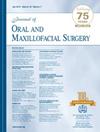使用美国正畸委员会差异指数比较传统与虚拟模型手术在节段性上颌正颌手术中的咬合效果。
IF 2.6
3区 医学
Q2 DENTISTRY, ORAL SURGERY & MEDICINE
引用次数: 0
摘要
背景:在某些情况下,上颌分割是通过纠正横向差异、博尔顿差异、弓畸形和牙槽角来实现最佳咬合的必要条件。尽管传统的石膏模型技术耗时且容易出错,但尽管虚拟手术计划具有优越的精度和效果,许多外科医生仍继续使用它们在上颌节段性手术中设置咬合。有限的研究直接比较了基于虚拟手术计划的分割与传统模型手术的临床应用。目的:本研究的目的是比较上颌节段性手术术前口内扫描通过常规手术和虚拟模型手术获得的计划咬合。研究设计、背景、样本:一项体外研究使用了上颌节段性手术患者的存档的、去识别的术前口内扫描。纳入标准为需要3片Le Fort I截骨术的病例。排除标准包括部分全牙或腭裂病例。预测变量:预测变量是用于上颌分割的模型手术类型(传统vs虚拟)。主要结果变量:主要结果变量是计划咬合结果,由2名对模型手术技术不了解的正畸医生评估,使用美国正畸委员会(ABO)差异指数进行测量。共:没有。分析:参数统计测试比较了不同方法的咬合结果和计划时间。双尾t检验分析ABO指标差异和计划时间,P < 0.05显著性水平。结果:两名外科医生使用随机20次口内扫描对上颌节段性手术进行了虚拟和传统模型手术,最终产生80例闭塞(40例常规闭塞,40例数字计划闭塞)。两名正畸医生使用ABO差异指数(160次评估)评估每个最终咬合。常规计划组ABO差异指数均值为9.99 (SD = 6.76),虚拟计划组ABO差异指数均值为4.69 (SD = 4.60),差异有统计学意义(P < 0.001)。虚拟规划更快,平均减少25分28秒(SD = 5:34;P < 0.001)。结论和相关性:研究结果表明,虚拟模型手术在获得更好的术前咬合效果方面优于传统方法,同时减少了总体计划时间。本文章由计算机程序翻译,如有差异,请以英文原文为准。
Comparison of Occlusion Using Conventional Versus Virtual Model Surgery in Segmental Maxillary Orthognathic Surgery Using the American Board of Orthodontics Discrepancy Index
Background
Maxillary segmentation is essential for achieving optimal occlusion in some cases by correcting transverse discrepancies, Bolton's discrepancy, arch deformities, and alveolar angulation. Although traditional plaster model techniques are time-consuming and error-prone, many surgeons continue using them to set occlusion in segmental maxillary surgery despite the superior precision and outcomes of virtual surgical planning. Limited research has directly compared the clinical utility of virtual surgical planning–based segmentation versus traditional model surgery.
Purpose
The purpose of the study was to compare the planned occlusion obtained through conventional and virtual model surgeries performed on preoperative intraoral scans for segmental maxillary surgery.
Study Design, Setting, Sample
An in vitro study was conducted using archived, de-identified preoperative intraoral scans from patients who underwent segmental maxillary surgery. Inclusion criteria were cases requiring a 3-piece Le Fort I osteotomy. Exclusion criteria included cases with partial edentulism or cleft palate.
Predictor Variable
The predictor variable was the type of model surgery (conventional vs virtual) used for maxillary segmentation.
Main Outcome Variable(s)
The primary outcome variable was planned occlusion outcomes measured using the American Board of Orthodontics (ABO) discrepancy index assessed by 2 orthodontists blinded to the model surgery technique used.
Covariates
None.
Analyses
Parametric statistical tests compared occlusal outcomes and planning times between methods. Two-tailed t-tests analyzed ABO index differences and planning times, with a significance level of P < .05.
Results
Two surgeons conducted both virtual and conventional model surgery for segmental maxillary procedures using random 20 intraoral scans, resulting in 80 final occlusions (40 conventional and 40 digitally planned). Two orthodontists evaluated each final bite using the ABO discrepancy index (160 assessments). The mean ABO discrepancy index was 9.99 (SD = 6.76) for conventional and 4.69 (SD = 4.60) for virtual planning, with a statistically significant difference of 5.30 (P < .001). Virtual planning was faster, with an average time reduction of 25 minutes and 28 seconds (SD = 5:34; P < .001).
Conclusions and Relevance
The findings suggest that virtual model surgery outperforms conventional methods in achieving superior preoperative occlusal outcomes while reducing overall planning time.
求助全文
通过发布文献求助,成功后即可免费获取论文全文。
去求助
来源期刊

Journal of Oral and Maxillofacial Surgery
医学-牙科与口腔外科
CiteScore
4.00
自引率
5.30%
发文量
0
审稿时长
41 days
期刊介绍:
This monthly journal offers comprehensive coverage of new techniques, important developments and innovative ideas in oral and maxillofacial surgery. Practice-applicable articles help develop the methods used to handle dentoalveolar surgery, facial injuries and deformities, TMJ disorders, oral cancer, jaw reconstruction, anesthesia and analgesia. The journal also includes specifics on new instruments and diagnostic equipment and modern therapeutic drugs and devices. Journal of Oral and Maxillofacial Surgery is recommended for first or priority subscription by the Dental Section of the Medical Library Association.
 求助内容:
求助内容: 应助结果提醒方式:
应助结果提醒方式:


